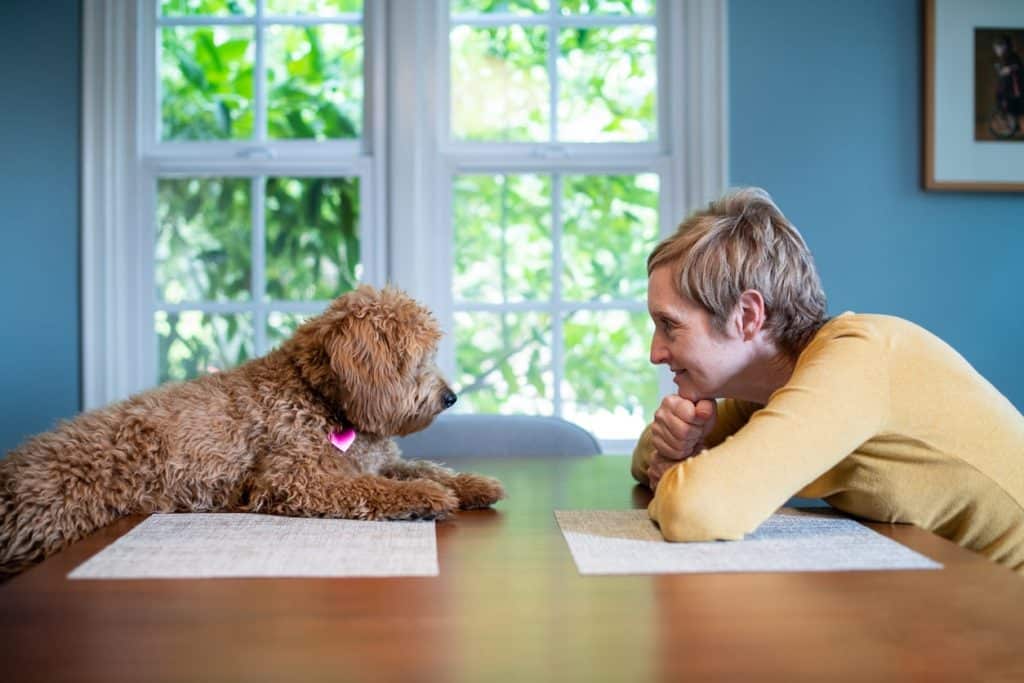Have you ever tried to communicate with a dog, only to be met with a tilted head and a wagging tail? As pet parents, we love talking to our furry friends and forming a deep bond with them. But do dogs truly understand and enjoy communicating with us? Yes, dogs do enjoy communicating with us. They are social animals and thrive on human interaction and companionship.
Speaking ‘dog’ is not about mastering a specific language; instead, it’s about understanding and responding to your dog’s needs and emotions. The best way to speak dog is by using body language, a certain tone of voice, and consistent commands. The more you engage in meaningful communication, the stronger your bond with your dog will become, creating a harmonious and fulfilling relationship.
Below, we’ll explore how to speak dog, what dogs actually hear, and dog communication mistakes pet parents can avoid.
6 Ways To ‘Speak’ With Your Dog
- Body language. Dogs are experts at reading body language, so it’s the most effective method to ‘speak’ with your dog. Our pups pay close attention to our facial expressions, posture, and gestures. By using open and relaxed body language, staying on their level, and inviting your dog to play, you can convey a sense of calm and trust to our canine companions.
- Tone of voice. Dogs are highly attuned to the tone of our voice. They can sense our emotions based on how we speak. Using a warm, friendly tone communicates love and affection, while a stern tone conveys authority and discipline. Meaghan Thomas, DVM, a veterinarian at East Ridge Animal Hospital reaffirms that short sayings in a pleasant tone are likely the best ways to communicate with your dogs. “Using words that are related to dogs (i.e. good, walk, ride, treat) will keep your dog’s attention for longer as well,” she adds.
- Commands. Dogs are responsive to specific commands we teach them. Common commands such as ‘sit’, ‘stay’, and ‘come’ create a clear line of communication between you and your dog, enabling them to understand your expectations.
- Eye contact. Establishing eye contact with your dog can strengthen the bond between you. It shows attentiveness and interest. However, be aware that prolonged direct eye contact may be perceived as a threat by some dogs, so it’s important to observe their response.
- Saying hello. When meeting a dog, it’s crucial to approach them calmly and respectfully. Avoid making sudden movements or towering over them, as these actions can be intimidating. Instead, crouch down to their level, allowing them to sniff and investigate you. This demonstrates that you are non-threatening and friendly. Dr Thomas adds that dogs use their sense of smell to recognise familiarity.
- Dog talk buttons. Some pet parents have embraced the use of specialised buttons that dogs can press to ‘speak’ or communicate their needs. These buttons can be labelled with words like ‘food’, ‘outside’ or ‘play’, allowing dogs to communicate in a unique way.
Dogs do have their own language, consisting of various vocalisations, body postures, and facial expressions. Barking, growling, whimpering, and howling are all part of their vocal repertoire. Additionally, dogs use body postures such as wagging tails, raised hackles, and lowered ears to communicate their emotions. Understanding these signals can help you interpret what your dog is trying to convey and respond accordingly.

iStock/Spiderplay
What Do Dogs Hear When We Talk?
While dogs may not understand the exact words we say, they can pick up on certain sounds and patterns in our speech. Dr Thomas explains that they respond more to the tone, pitch, and inflection of our voices rather than the content itself. She says that dogs can sense our moods based on pitch and dialect. Speaking in a calm and gentle manner can help soothe an anxious dog, while an excited tone can convey happiness and enthusiasm.
To express your love to your dog, you don’t need to speak English. Dogs primarily respond to our actions and physical affection. Spending quality time with your dog, offering belly rubs, playing games, and going for walks are all ways to show your love in their language. Remember, actions often speak louder than words.
What Communication Mistakes Should You Avoid?
- Yelling or shouting. Raising your voice at your dog can create a negative and fearful response. “This can alter your bond with your animal, and may cause aggressive or fearful reactions toward you as well as other people,” Dr Thomas says. Dogs are sensitive to loud noises and may interpret yelling as aggression. Instead, use a firm but calm tone to communicate your expectations.
- Punishment-based training. Using harsh punishments or physical force to train your dog can damage the trust and bond between you. Positive reinforcement, such as rewards and praise, is a more effective and compassionate approach to teaching desired behaviours.
- Ignoring them. Dogs communicate through their body language, and it’s essential to pay attention to their cues. Ignoring signs of fear, anxiety, or discomfort can lead to stress and may escalate into behavioural issues. Respect your dog’s boundaries and provide a safe space for them.
- Inconsistent commands. Dogs thrive on consistency. Using different words or gestures for the same command can confuse your dog and make it difficult for them to understand what you want. Stick to clear and consistent commands to avoid confusion.



